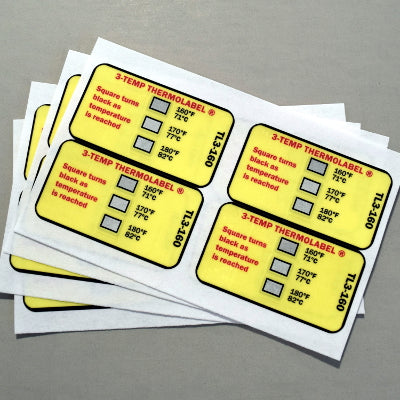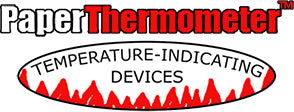Temperature Labels for Food Service Question & Answer
View/Download Printable PDF
Buy Dishwasher Temperature Labels Here
Below are some common dish sanitation temperature related questions we get here at Paper Thermometer Company. To learn more about using temperature labels to test sanitation temperature in commercial dishwashers try here. Also see our complete offering of Thermolabels for Food Service. Or go right to the source and download the latest edition of the FDA Food Code here.

What exactly is an “irreversible registering temperature indicator”? The most common type is a temperature label which will indicate the temperature without reverting back after the test. The label becomes a permanent record that the temperature has been reached.
Why don’t I need to test for 180°F, I thought I remembered this was the temp I needed to test for? The FDA Food Code regulation is 160°F on the dish surface. The confusion stems from the requirement that the rinse water be at least 180°F to achieve the 160°F dish temp.
What temperature does the final rinse water need to be set to? The rinse water needs to be at least 180°F. Section 4-501.112 of the Food Code also dictates that the final rinse water temperature cannot exceed 194°F or “the water becomes volatile and begins to vaporize reducing its ability to convey sufficient heat to utensil surfaces”. So you have a possible range of 180°F to 194°F for your final rinse water. Within that range, the water needs to be hot enough to bring the dishware to the required sanitation temperature of 160°F.
How can I test that the final rinse water is reaching 180°F? The Dishwasher Rinse Temp Thermolabe® accurately reads the temperature of a dishwasher’s rinse water. It has been designed to do what a typical temperature label on a dish cannot; show if the final rinse has reached the required 180°F.
Why did the 180°F label that I put on a dish not change color, my rinse water is over 180°F? The required sanitation temperature is 160°F measured on the surface of a piece of dishware. 180°F or higher rinse water is needed to bring the dishware to that 160°F. It is not possible to bring the surface temperature of dishware to 180°F in a commercial dishwasher with the rinse water set to an FDA acceptable temperature. Due to the rinse water temperature dropping as it reaches the cooler environment in the dishwasher, a 180°F label on a dish surface will never blacken. Read more here.
Can I reuse the temperature label after it runs through the dishwasher? If the label did not blacken (indicate temperature) then it can be used to test again. A label that has indicated temperature is a lasting record of the temperature reached and cannot be used again. It will not change back. Note that peeling off the label and reapplying may weaken the adhesive.
How often should I test that my dishmachine is reaching the correct dish sanitation temperature? Frequency of testing is a matter of guidance from local health officials or an individual institution’s policy. If no guideline has been given, once a week testing would be an appropriate suggested frequency.
Where do I attach the temperature label? The temperature label must be affixed to a dish, pan, knife or other piece of clean dishware. Do not attach the label to the rack or the interior of the dishwasher, this will not confirm that your dishwasher is sanitizing the dishware.
Why is it not recommended to test on the first wash cycle of the day? We recommend running a few cycles before testing dish surface sanitation temperature in order for the dishwasher to warm up. The metal parts of the dishwasher will absorb a significant amount of heat from the wash and final rinse water. This will mean less heat available to bring the dishware up to the required sanitation temperature. It is best to run 2-3 cycles to allow the dishwasher to heat up before testing in order to get the most accurate results.
Does it really matter if the dishes are actually reaching 160°F? Proper sanitation by either heat or chemical means is critical to a safe food service environment. A high temperature dishwasher must consistently bring the dishware surface to 160°F to effectively sanitize. Failure to sanitize dishware properly risks sickening customers and can cause costly lawsuits.
What do I do if the temperature label doesn’t turn black? First repeat the test. Make sure your machine has had enough time to properly come to temperature. Run a few cycles and test again. Try a different piece of dishware. If your temp label is still not changing to black then your dishes are not being sanitized. Likely your rinse temperature needs to be increased slightly. Contact your service technician.
What is a dishwasher temperature log? A dishwasher temperature log is part of HACCP-based food safety management and is used to maintain records of sanitation temperature testing for a particular dishwasher. It allows a person to view the history of temperature tests and confirm at a glance that the dishwasher has been sanitizing correctly. You can download and print your own HACCP-Based Dishwasher Temperature Log pages here.
